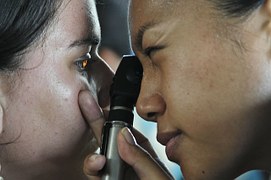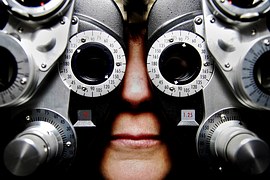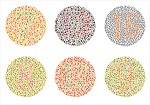The Eye Examination Explained
If you wear glasses or contact lenses, you likely see your Optometrist every year or two. If you have good vision, it’s possible you haven’t had your eyes examined since you were in junior school. Eyesight is often taken for granted, but you use it every day, thousands of times, to navigate the world, complete your work, read a book, watch a movie or pick a loved one out of a crowd. Some people refer to an eye exam as an eye test, however an eye test forms only part of the full eye exam. Understanding what happens during an eye exam and the individual tests involved will help demystify them and help explain why they are so important for eye health, vision and your general health.
Why Are Eye Exams Important?

There are two primary reasons for an eye exam: to judge your visual acuity and to check for signs of eye disease. Both goals are interlinked and one may have a serious impact on the other. For example, poor vision could point to eye disease, such as macular degeneration or glaucoma, or it could just mean you need corrective lenses. Many eye diseases have almost no noticeable symptoms at first and any lost vision may not be recoverable, making routine exams crucial for early diagnosis. On the other hand, perfectly healthy eyes often need correction for sharp, clear vision. You can’t know where you stand without a thorough examination.
How Often Do I Need An Eye Exam?
Optometrists recommend that healthy individuals get a test every two years. However, sight tests may be needed more frequently if you have diabetes, are over the age of 40 and have a family history of glaucoma, are over the age of 70, or if you are a child who wears glasses. The NHS offers free sight tests for all these categories plus more, they also offer optical vouchers to help cover some of the cost of prescription glasses. To check if you are eligible for a free sight test and or an optical voucher check out the NHS's criteria.
What Happens During An Exam?
While every Optometrist or Optician practice has its own routines, there is a general outline of what happens during an eye exam. In most cases, you will be seated and given some forms to fill out. You want to be as open and detailed as possible about your health history, current health and the health of your family, if you know it. Many eye diseases are inherited or stem from your own health issues, so being as honest and as detailed as possible will help. If you use recreational drugs or have a drinking problem, disclose that on your forms. No one will judge you. Drugs, smoking and excessive alcohol can impact your eyes and vision, so it’s important that you are honest. The same can be said for prescription drugs, even if your doctor has prescribed them.
After filling out your forms, you may go directly to the Optometrist or you may be pre-tested by an optical assistant. Optical technicians or optical assistants can put you through a few preliminary tests, mark the results on your forms and create a chart for you. Some optical professionals do all of this themselves and do not have an assistant. Either way, later testing will confirm the results of these preliminaries, so don’t be nervous if you’re pre-tested by an assistant.
Once pre-testing is concluded, you’ll be seen by your Optometrist. He or she will conduct several tests and a thorough examination of your eyes. If all is well, you will now have your eyeglass or contact lens prescription. If you need to order glasses or contact lenses, you may then speak to a dispensing optician or the optometry technician. In some smaller practices, your Optometrist may help you choose your corrective lens options and frames. If you are trying contact lenses for the first time, you will be instructed on proper insertion and removal, as well as lens care. In most cases, a dispensing optician will be available to help you with other needs, such as getting fitted for glasses.
For most people, a full eye exam will take under an hour from start to finish and you can go about your normal routine, drive, return to work etc, however, if the Optometrist has put drops in your eyes to dilate your pupils will need to arrange for someone to drive you home, because your vision may be blurry for about an hour after your exam. If this isn’t possible, taking a cab or riding public transportation is also acceptable. Alternatively, some patients decide to go shopping or have a meal at a nearby restaurant after their appointment, to give their vision time to recover before driving home.
The Testing During An Exam
There are several different tests used by your optometrist or ophthalmologist during a routine exam. All of them are designed with a specific purpose and none of them are painful.
Visual acuity test
is one of the most common and familiar eye tests. You will be asked to read letters from a chart with letters on it called a Snellen chart. The chart will usually be across the room from you. This tells your doctor if you need corrective lenses.
Visual field test
gauges your ability to see in your entire field of vision. You will be asked to stare straight ahead and lights will flash in different areas of your vision. You will need to press a button every time you see a flash. This test is designed to find deficiencies in your visual field months or years before you would notice them on your own. As it involves flashing lights, please tell your doctor or technician if you have epilepsy.

Refraction assessment
uses the large ‘mask’ you’re likely already familiar with. The mask, called a phoropter, holds lenses inside that can be changed. You’ll be asked to look through the mask, likely at the Snellen chart again, and say which lens provides sharper vision. This helps the doctor write your final lens prescription.
Indirect ophthalmoscopy
isn’t a test but an examination. Your doctor will put a light source on their head and peer into your eyes to view the retina and the optic nerve at the back of your eye. Before this can be done, your doctor may put dilation drops in your eyes to widen your pupils and create a better view. The drops are what can make your vision blurry for an hour or so.
Slit-lamp examination
is used to carefully look over the clear structure at the front of your eye, called the cornea. The slit-lamp shines a narrow beam of light over the cornea, making any abnormalities visible. This is also the same test used if you believe you’ve scratched your eye or have a foreign body in your eye.
Tonometry test
measures how much pressure is needed to flatten your cornea temporarily. It can be done with a device that touches the eye, or it can be done using a tonometry machine that blows a puff of air onto your eye. If you find the air-puff test too startling or uncomfortable, most optometrists and ophthalmologists have an alternative method to use. This test measures the pressure inside your eye and is used to detect glaucoma.

Colour Vision Test
measures how good your colour vision is, and if it is defective in any way. Typically they will use a test called an Ishihara Test, which shows numbers on a coloured background.
There are many other tests at your Optometrist's disposal. He or she will run additional tests and explain them to you if they are warranted.
Why Do Optometrists Dilate Your Eyes?
Pupil dilation is performed to increase the size of your pupil thereby allowing more light into your eye so that your Optometrist can see the retina and optic nerve at the back of your eye. Your Optometrist needs to assess the condition of both the retina and optic nerve to help diagnose, monitor, and/ or eliminate common conditions that can affect your eye including but not exclusively
- High Blood Pressure
- Glaucoma
- Diabetes
- Macular Degeneration
- Retinal Detachment
Many Optometrists now use non dilating digital retinal photography to take high-resolution images of the back of the eye, without the need for dilating drops. They also have the advantage of storing a hard copy of what is recorded, for future comparison. It is worth asking if this service is available and if there is an extra fee for it.
When Should I Have My First Eye Test?
Free NHS funded sight tests are available for all children under the age of 16, and teenagers under 18 in full-time education.
An infant should have their first eye exam at six months (see: vision development in infants) if there are no signs of trouble and immediately for children who develop any concerning symptoms or risk factors.
Risk factors include:
- The baby was premature or suffered fetal distress, was the product of an assisted labour or had a low Apgar score at birth.
- The mother had an infection during pregnancy, such as AIDS, toxoplasmosis, rubella, herpes or venereal disease.
- There is a family history of eye issues, such as congenital cataracts or retinoblastoma.
- The child has issues with their nervous system, such as seizures, hydrocephalus, cerebral palsy or any kind of developmental delay.
The child should be seen again at three years and once more before first grade, then every two years until they turn 18. This schedule is, of course, only a guideline. A child who needs glasses may need to see an optometrist more frequently, as prescription strength can change dramatically as children grow.
If you have sailed through life with perfect vision, congratulations, but you may wonder why as you approach your vision appears to be getting worse, don't panic -
Some people with good natural vision never get eye exams and never seem to need one. That is until they creep closer to forty. Around the age of forty, give or take five years, the vast majority of people start to lose the ability to focus close up. They start holding books and newspapers farther and farther from their eyes, relying on their still-sharp middle-distance vision. This is called presbyopia, and it happens to almost everyone who is not already extremely nearsighted. When this happens, get an eye exam, so that the condition can be diagnosed and glasses or contact lenses prescribed to bring your vision back to normal, your eyes can also be fully checked over for any signs of eye or health issues.
The Roles Of Optometrists And Ophthalmologists
As with the eye exam itself, the professions of Optometrists and Ophthalmologists are closely related and linked.
Optometrists are healthcare professionals who provide primary vision care. They focus on performing sight tests and finding signs of diseases, correcting the diagnosis, and offering treatment and management of vision changes, such as prescribing corrective lenses. An Optometrist has had at least 3 years of university, then 1 year of supervised practice. An Optometrist receives a BSc MCOptom.
Ophthalmologists are medical doctors who specialise in eye and vision care. They focus on treating eye disease and performing surgeries. Ophthalmologists have completed at least 7 years of medical training. In large cities or multi-doctor practices, you may note that some Ophthalmologists narrow their focus even further. As such, you may see an Ophthalmologist who is a retinal specialist or a corneal specialist.
In general, your Optometrist is interested in finding signs of disease and getting you the best corrective lenses possible. Your Ophthalmologist is interested in treating and slowing the progression of disease, up to and including surgical procedures. Both are very important roles, but have their own focus.
Dispensing Opticians are trained to verify and fit eyeglasses, lenses, eyeglass frames, and contact lenses. To perform these actions, they use the prescriptions which were supplied by an Optometrist or Ophthalmologist. Dispensing opticians do not diagnose or treat eye problems.
Author: John Dreyer Optometrist Bsc(Hons), MCOPTOM, DipCLP
Created: 25 Mar 2017, Last modified: 7 Jan 2025

